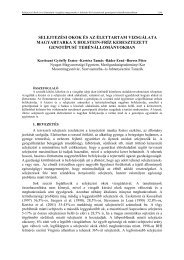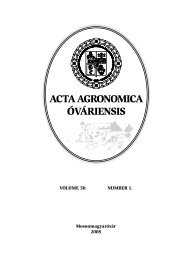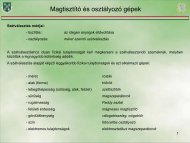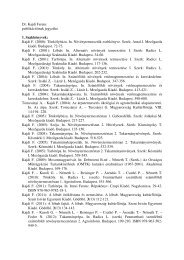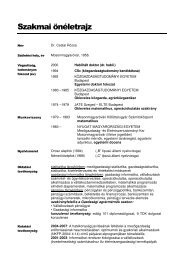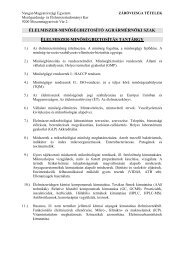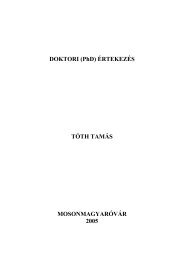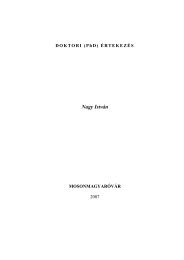teljes anyag - Nyugat-Magyarországi Egyetem Mezőgazdaság
teljes anyag - Nyugat-Magyarországi Egyetem Mezőgazdaság
teljes anyag - Nyugat-Magyarországi Egyetem Mezőgazdaság
You also want an ePaper? Increase the reach of your titles
YUMPU automatically turns print PDFs into web optimized ePapers that Google loves.
Most frequent bovine diseases in cattle herds in the West-Transdanubian Region53Metabolic diseasesProduction diseases are caused by the disharmony of genotype, feeding and keeping failuresthat result in metabolic problems. Their occurrence, spread and severity of symptoms riseparallel with higher yields and fertility. First of all we must mention acetonaemia, whichreduces the milk yield and prolificacy. Cows suffering from acetonaemia produce daily 10litres milk less than healthy cows. Veterinary examinations confirm that on average 40 outof 100 cows in lactation fall sick with sub-clinical acetonaemia once, and 5 out of 100 fallill with clinical acetonaemia. (Brydl1997). Calculating with a minimal loss of 10% per yearit will result 600–800 litres non-produced milk per cow, a loss of 43–57 thousand HUF percow per year at present milk prices. On a dairy farm with 500 cows the loss estimationsare as high as 11–14.5 million HUF per year (Brydll 1997). Researchers assume that reallosses are much higher because the damage is more complex. Diseases after calving cancause premature culling, which may reduce the beneficial lifetime of the cows by 3–4years (Brydll 1997). Considering the mentioned losses the only possible way to increasethe profitability of dairy stock is the reduction of losses and disease prevention.Foot diseasesAccording to the investigations 25% of lameness is long lasting, up to 17 weeks at thebeginning of the lactation and later on it may last 12 weeks. Milk loss in the first periodof lactation may exceed 440 kg, later on it goes back to 270 kg, and i.e. milk yield reducesat a higher rate at the beginning of lactation (Coulon and Landais 1989). Cows with wellbuilt foot exceed the average milk performance of the group in the lactation periods 2and 3 by 200–300 kg. The highest rate of losses, about 65%, is the result of milk yieldreduction and poor quality (Bargai and Levin 1993). Returning lameness can be blamedfor 640 kg milk loss during the total lactation period. Losses are not only caused by thereduction of milk quality but also by the fact that milk of infected cows cannot be utilisedowing to antibiotic treatments. Foot diseases influence the cows’ condition, their fertility,vet costs and culling rate growth. In the UK there is an average loss of 45$ per yearand per cow (Esslemontt 1998). World wide 25% of cows must be treated because of footproblems (Nagy2001). Data published by USDA (1993) confirm that 15% of dairy cowsare slaughtered due to lameness. Lameness is the third of most important diseases afterinfertility (26.7%) and mastitis (26.5%) that involve not wanted culling. Among the causeswe should mention failures in animal hygiene, keeping, placement and floor conditions,deficient farm buildings as well as climatic and stress factors.Bovine Infectious Diarrhoea (BVD)BVD infection is wide spread in dairy herds of Hungary. The virus can cause severaldamages not only in infected stocks, but in those without symptoms and in their offspring.A summary of losses caused by the virus indicates how much higher income could bereached if the stock were virus free. Ózsvári et al. (2001b) elaborated some software that




